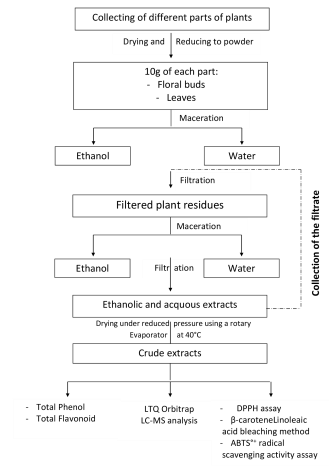
Phenolic composition and antioxidant activity of different parts of pistacia vera L.
Abstract
Phenolic compounds are widely distributed in almost all higher plants and are present in different tissues. The quality and quantity of phenolics are used as criteria for variety identification. The present study has been planned to determine the phenolic composition of Pistacia vera. Total phenolic content and concentration of flavonoids of eight different extracts, from the floral buds and leaves of Pistacia vera. (Anacardiaceae) were determined using spectrophotometric methods. The total phenolic content ranged from 401.64 to 513.77 (mg GAE/g DW). The total flavonoid concentrations varied from 8.28 to 67.94 mg CE/g. Antioxidant activity was assessed by three methods: DPPH°+, β-carotene and ABTS and determined respectively as IC50 (mg/mL), CAA and PI (%), all extract have shown to be endowed by a high antioxidant activity similar to that of BHT. Ethanolic extract of male floral buds showed the highest phenolic and flavonoid concentration and the strongest antioxidant activity. The significant linear correlation was confirmed between the values for the total phenolic content and antioxidant activity of plant extracts. Phenolic compounds were investigated by LTQ Orbitrap LC-MS analysis and revealed 17compounds split into 5 groups: Abscisic acids, phenolic acids and their derivatives, flavonols, flavanones, flavones, flavanols. The high contents of phenolic compounds indicated that these last contribute to the antioxidant activity. The Pistacia vera can be regarded as promising candidates for natural plant sources of antioxidants with high value.
Full Text:
PDFReferences
- D. Solecka, Role phenylpropanoid compounds in plant response to different stress factor. Acta Physiol. Plant., 1997, 19: 257-268
- L.G. Korkina, Phenylpropanoid as naturally occurring antioxidant from plant defense to human health. Cell Mol. Biol., 2007, 53, 15-25.
- Ferguson, L., Polito, V., & Kallsen, C. (2005). The pistachio tree; botany and physiology and factors that affect yield. Pistachio production manual, 4th ed. Davis, CA, USA, University of California Fruit & Nut Research Information Center, 31-39.
- I. Acar, B.E. Ak BE, an investigation on pollen germination rates of some selected male trees at ceylan pinar state farm. Cahiers options Mediterranean's, vol: 33. Xgrempa seminar. 2001, 63-66.F. Monastra, D. Avanzato, E. Lodoli, Il pistacchio nel mondo. Confronto tra la pistacchicoltura delle aree tradizionali e quella emergente degli Stati Uniti. Agricoltura Ricerca-II, 1987, (75-80), 1-8.
- S.N.M. Parvardeh, H. Hosseinzadeh, Hepatoprotective activity of Pistacia Vera L. gum extract in rats. J. Med. Plants, 2002, 4, 27-34.
- S.H. Ansari, J.S. Qadry, M. Ali, Essential oils of Pistacia integerrima galls and their effect on the central nervous system. Int. J. Pharmacog., 1993, 31: 89-95.
- S.A. Kawashty S.A. Mosharrafa, M. El-Gibali, N.A. Saleh, The flavonoids of four Pistacia species in Egypt. Biochem. Syst. Ecol., 2000, 28, 915-7.
- S. Kusmenoglu, K.H.C. Baser, T. Ozek, Constituents of the essential oil from the hulls of Pistacia vera L. J. Essent. Oil Res., 1995, 7, 441-2.
- A.J. Hou, L.Y. Peng, Y.Z. Liu, Z.W. Lin. H.D. Sun, Gallotannins and related polyphenols from Pistacia weinmannifolia. Planta Med., 2000, 66, 624-6.
- G.A. Spanos, R.E. Wrolstad, Influence of processing and storage on the phenolic composition of Thompson seedless grape juice. J. Agric. Food Chem., 1990, 38, 1565-1571.
- V. Dewanto, X. Wu, K. Adom, R. Liu, Thermal processing enhances the nutritional value of tomatoes by increasing the total antioxidant activity. J. Agric. Food Chem., 2002, 50(10), 3010-3014.
- S. Oelschlaegel, M. Gruner, P.N. Wang, A. Boettcher, I. Koelling-Speer, K. Speer, Classification and characterization of manuka honeys based on phenolic compounds and methylglyoxal. J. Agri. Food Chem., 2012, 60 (29), 7229-7237.
- Y. Chen, M.F. Wang, R.T. Rosen, C.T. Ho, 2,2-Diphenyl-1-picrylhydrazyl radical-scavenging active components from Polygonum multiflorum Thunb. J. Agric. Food Chem., 1999, 47, 2226-2228.
- G.K. Jayaprakash, T. Selvi, K.K. Sakariah, Antimicrobial and antioxidant activities of grape (Vitis vinifera) seed extracts. Food Research International, 2003, 36, 117-122.
- K.P. Suja, A. Jayalekshmy, C. Arumughan, Antioxidant activity of sesame cake extract. Food Chem., 2005, 91, 213-219.
- P. Re, R. Proteggenate, N. Pannala, C.M.A. Rice-Evans, Antioxidant activity applying an improved ABTS°+ radical cation decolorization assay. Free Radical Bio. Med., 1999, 26, 1231-1237.
- C.A. Rice-Evans, N.J. Miller and G. Paganga, Antioxidant properties of phenolic compounds, Trends Plant Sci., 1997, 2, 152-159.
- B. Winke-Shirley, Biosysthesis of flavonoids and effects of stress. Plant boil., 2002, 5, 218-223.
- C.A. Rice-Evans, N.J. Miller, G. Paganga, Antioxidant properties of phenolic compounds. Trends Plant Sci., 1997, 2, 152-159.
- V. Katalinic, M. Milos, M. Jukic, Screening of 70 medicinal plant extracts for antioxidant capacity and total phenols. Food Chemistry, 2006, 94, 550-557.
DOI: http://dx.doi.org/10.13171/mjc61/0160920510-rb
Refbacks
- There are currently no refbacks.
Copyright (c) 2016 Mediterranean Journal of Chemistry
